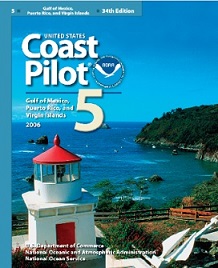All vessels should keep an updated list of nautical publications as per regulations set by IMO. After a new edition published, it should be entered along with edition on board to keep a check until it is received.
The Nautical Publications will include Sailing Directions, List of Lights, Tide Tables, List of Radio signals, Nautical Almanac, Charts Catalogue, Mariners Handbook, and others necessary for the safe navigation of the ship.
To correct a Sailing Direction (Pilot), the correction index on the inside of the front cover is used to record weekly corrections (from Notices to Mariners / Digitrace) and also the affected pages in the Sailing Direction.
The corrections are filed in a dedicated file, in individual sections for each Sailing Direction on board.
When using the Sailing Direction, reference should be first made to this index and then if any corrections are applicable to the concerned page, same can be consulted in the file.
For corrections to Admiralty List of Lights & Fog signals and Admiralty List of Radio Signals, these should be pasted on top of the existing (superseded) entry in the publication and the correction index at the front of the publication updated.
Smaller corrections may also be done by Pen, in the Publication.
ECDIS Corrections
Vessel must correct the ECDIS by inserting the disc received regularly from company in the computer.
After correction, this should be written on the disc face by permanent marker and all such disks retained on board for 1 year.
Please note the following navigation warning received today from the UK MCA on safe navigation.
Mariners are advised that ECDIS (Electronic Chart Display and Information System) may not display
some isolated shoal depths when operating in "base or standard display" mode. Route planning and
monitoring alarms for these shoal depths may not always be activated. To ensure safe navigation and
to confirm that a planned route is clear of such dangers, mariners should visually inspect the planned
route and any deviations from it using ECDIS configured to display "all data". The automated voyage
planning check function should not be solely relied upon. The International Hydrographic Organization
(IHO) is leading technical action to resolve this matter.
Verification Of Corrections
The Master should verify the corrections from each Notice to Mariner on random charts or publication.
A prudent master shall also verify on a random basis, the ECDIS (where fitted) corrections by correlating with a paper chart notice.
Related Information
Admiralty Chart correction procedure
There are currently two methods of carrying out electronic chart corrections, either via Weekly Updates, CD or downloaded weekly from a recognised electronic chart supplierís data. The preferred method will be decided by the Management Office depending on the communications equipment onboard the vessel but in the majority of cases the lack of internet access will determine the update CD as the best option....
Navigational guideline for ships - use of bridge movement book
A Bell book must be used to record significant information pertaining to the vessels movements. There should be sufficient facts to be able to reconstruct the passage, if required at a later date, in conjunction with other data recording (Handwritten or Electronic).
Requirement of ECDIS training and implementation guideline
To ensure compliance with the ECDIS requirement, to ensure that the transition is smooth, equipment installed and Master and Bridge watch keepers are all provided generic and ship-specific ECDIS equipment training before the implementation dates of various type vessel: .....
What are the conditions that should be reported to master while navigating ship ?
....
The officer of the watch shall notify the Master immediately in the following circumstances:
1. When visibility becomes less than 3 nautical miles.
(minimum criteria 3 miles; Master can increase this) ....
What are the safe navigational procedure for the officer of the watch ?
....
The officer of the watch (OOW) shall comply with masters standing orders (including any supplementary instructions) to carry out the navigational watch. He must always bear in mind that he is the Masterís representative and has primary responsibility at all times for the safe navigation of the ship and for fully complying with the latest COLREGS
.....
What are the entries to be made in deck log book ?
....
The Deck Log Book is an important document and serves as necessary evidence in case of any Accidents and Casualties. It must contain Factual Entries with Time in each entry. It is essential that clear and accurate record of the activities of the ship are kept, as the Log book will form a main part of the collection of evidence in case of any incidents.....
Guidance on ECDIS- data presentation and performance check standards
Type approval is the certification process that ECDIS equipment must undergo before it can be considered as complying with the IMO Performance Standards for ECDIS. The process is conducted by type approval organisations and marine Classification Societies.
...

Other info pages !
Ships Charterparties Related terms & guideline
Stevedores injury How to prevent injury onboard
Environmental issues How to prevent marine pollution
Cargo & Ballast Handling Safety Guideline
Reefer cargo handling Troubleshoot and countermeasures
DG cargo handling Procedures & Guidelines
Safety in engine room Standard procedures
Questions from user and feedback Read our knowledgebase
Home page

ShipsBusiness.com is merely an informational site about various aspects of ships operation,maintenance procedure,
prevention of pollution and many safety guideline. The procedures explained here are only indicative,
not exhaustive in nature and one must always be guided by practices of good seamanship.
User feedback is
important to update our database. For any comment or suggestions please Contact us
Site Use and Privacy - Read our privacy policy and site use information.
//Home //Terms and conditions of use
Copyright © 2015 www.shipsbusiness.com All rights reserved.



